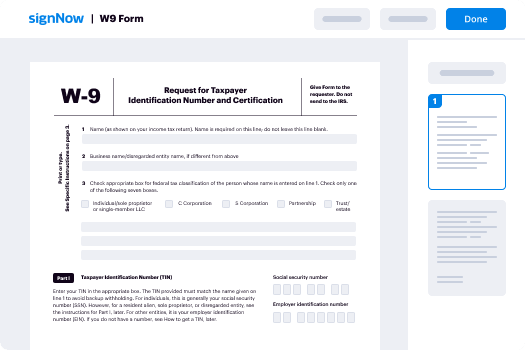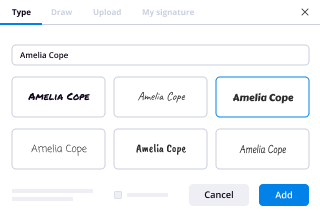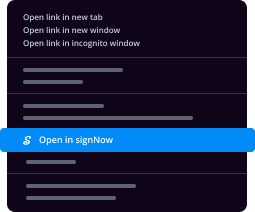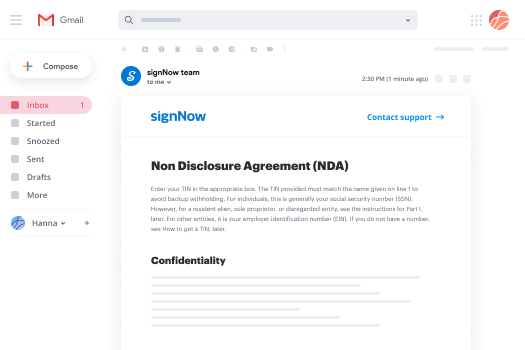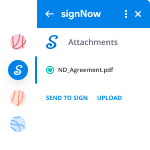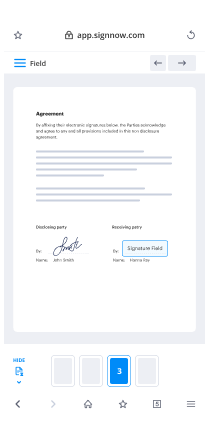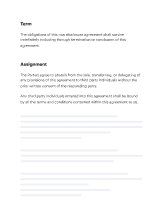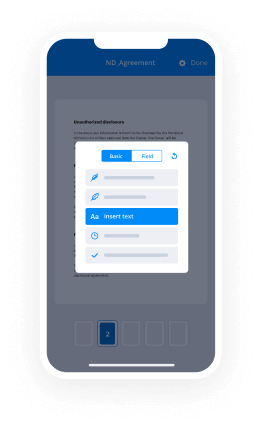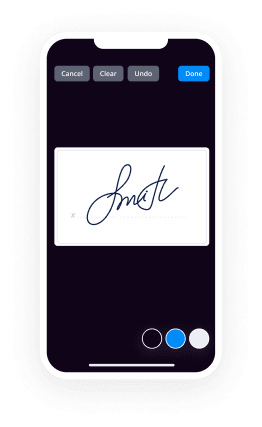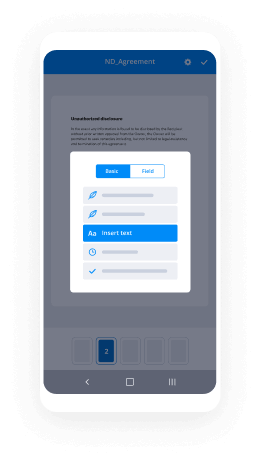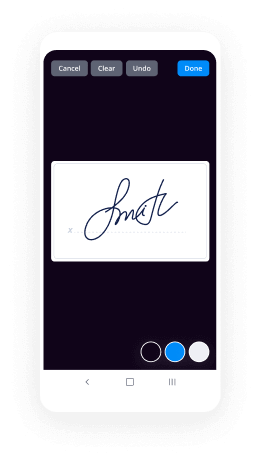Help Me With Add eSign in Word
Contact Sales
Make the most out of your eSignature workflows with airSlate SignNow
Extensive suite of eSignature tools
Robust integration and API capabilities
Advanced security and compliance
Various collaboration tools
Enjoyable and stress-free signing experience
Extensive support
Keep your eSignature workflows on track
Our user reviews speak for themselves






How to incorporate перевод слова using airSlate SignNow
If you're seeking to incorporate перевод слова into your documents effortlessly, airSlate SignNow provides an intuitive platform for signing and managing electronic paperwork. This guide will direct you through the procedures on how to efficiently utilize airSlate SignNow for your document signing requirements, ensuring you can manage your paperwork effortlessly while reaping the platform's numerous advantages.
Procedures to incorporate перевод слова with airSlate SignNow
- Launch your web browser and go to the airSlate SignNow website.
- Create a complimentary trial account or log in if you already possess one.
- Select the document you want to sign or send out for signatures.
- If you intend to use this document frequently, transform it into a reusable template.
- Access your document and make any essential modifications, such as adding fillable fields or inserting particular information.
- Add your signature and designate signature fields for additional recipients.
- Click on 'Continue' to complete your setup and send an eSignature invitation.
airSlate SignNow delivers a powerful solution that enables businesses to manage their document signing processes effortlessly. Its user-friendly interface combined with a comprehensive feature set ensures you receive great value for your investment.
Ready to simplify your document signing process? Begin your free trial with airSlate SignNow today and discover the advantages of transparent pricing, exceptional 24/7 support, and a platform tailored for small to mid-sized enterprises.
How it works
Rate your experience
-
Best ROI. Our customers achieve an average 7x ROI within the first six months.
-
Scales with your use cases. From SMBs to mid-market, airSlate SignNow delivers results for businesses of all sizes.
-
Intuitive UI and API. Sign and send documents from your apps in minutes.
A smarter way to work: —how to industry sign banking integrate
FAQs
-
What features does airSlate SignNow offer for users who want to add перевод слова?
airSlate SignNow allows users to efficiently add перевод слова to their documents by enabling electronic signatures and document editing. With its user-friendly interface, you can seamlessly incorporate translations and notes into your documents, ensuring clarity and understanding. This feature is particularly beneficial for businesses dealing with international clients.
-
How can I integrate airSlate SignNow with other applications to add перевод слова?
You can easily integrate airSlate SignNow with various applications like Google Drive, Dropbox, and Microsoft Office to facilitate the process of adding перевод слова. This integration allows for smooth document management and ensures that all necessary translations are available when you need them. The extensive API support also helps customize workflows to meet your specific needs.
-
Is airSlate SignNow a cost-effective solution for adding перевод слова?
Yes, airSlate SignNow is designed to be a cost-effective solution for businesses looking to add перевод слова to their documentation processes. With competitive pricing plans tailored to different business sizes, you can choose a plan that fits your budget while still accessing robust features. This makes it an ideal choice for companies aiming to streamline their document management without breaking the bank.
-
Can I try airSlate SignNow before committing to a subscription for adding перевод слова?
Absolutely! airSlate SignNow offers a free trial that allows users to explore its features, including how to add перевод слова to documents. This trial period gives you the opportunity to test the platform's capabilities and see how it can enhance your document signing and management processes before making a commitment.
-
What types of documents can I sign and add перевод слова to with airSlate SignNow?
With airSlate SignNow, you can sign a wide variety of document types and easily add перевод слова. Whether you are dealing with contracts, agreements, or forms, the platform supports numerous file formats, ensuring that you can include translations and notes as needed. This versatility makes it suitable for various industries and purposes.
-
How does airSlate SignNow ensure the security of documents while adding перевод слова?
airSlate SignNow prioritizes document security, especially when you add перевод слова to sensitive materials. The platform utilizes advanced encryption methods and complies with industry standards to protect your documents. This means you can confidently add translations knowing that your data is safe and secure.
-
What support options are available if I need help with adding перевод слова in airSlate SignNow?
If you need assistance with adding перевод слова in airSlate SignNow, there are several support options available. You can access a comprehensive knowledge base, contact customer support via chat or email, and participate in community forums for additional guidance. This ensures you have the resources needed to maximize your experience with the platform.
-
What are some useful skills I can learn in minutes?
I will post many skills with respect to computers which takes only few minutes to learn.1. MagnifierEver had problem while presenting; To enlarge what's on the screen, to make it more visible, try magnifier.Click on start, then search for magnifier on the search bar. Then click on magnifier.Then select the level to Zoom, you will see enlarged part of the screen just like in the image below.Shortcut: Press Windows+plus to open magnifier directly.2. Turn your Laptop into WiFi Hotspot.Copy the following lines into NotePad and save it as WiFi.batnetsh wlan set hostednetwork mode=allow ssid=WIFI key=password123netsh wlan start hostednetworkNow right click on the file and select "Run as administrator" , automatically WiFi hotspot will be turned ON.You can change the WiFi name by changing ssid=new name and password key=newpasswordImportant - For this to work, your sharing should be on in the network properties for the network/ethernet connection that you want to share through your wifi:Go to Open Network and Sharing Centre ->Change Adapter Settings(On left panel)Your wifi hotspot would be Microsoft Hosted Network Virtual Adaptor in the Network Connections.Go to the properties of the LAN/ethernet/WiFi connection and make the changes accordingly.There you can see the wifi Hotspot network.Your wifi hotspot would be ready.To turn Off the WiFi Hotspot, copy this code in a notepad file and save it as wifistop.bat then run that bat file as "Run as Administrator".netsh wlan stop hostednetwork3. Slide Between windows with awesome 3D flip Animation.Press and hold Winows+Tab to slide over windows.press Windows+shift+Tab to slide in reverse order.4. Subtitles for movies not Synchronized, Just follow this simple trick.Open the video in MPC (Media player classic) and pause the movie at a point, Then Click on View->subresync.Then you will see a window like belowAt a given point click on the line of subtitle which is correct for the scene, Right click on it and select current.The Subtitle will be automatically updated to that point.You can save the modified subtitle by File->Save subtitle.5. Want to hide some Files and Folders.You Might be tired of using File locker software which are difficult to use and ask for registrations.Follow the simple Tip.Open NotePad and paste the following codecls@ECHO OFFtitle Folder Lockerif EXIST "Control Panel.{21EC2020-3AEA-1069-A2DD-08002B30309D}" goto UNLOCKif NOT EXIST Locker goto MDLOCKER:CONFIRMecho Are you sure u want to Lock the folder(Y/N)set/p "cho=>"if %cho%==Y goto LOCKif %cho%==y goto LOCKif %cho%==n goto ENDif %cho%==N goto ENDecho Invalid choice.goto CONFIRM:LOCKren Locker "Control Panel.{21EC2020-3AEA-1069-A2DD-08002B30309D}"attrib +h +s "Control Panel.{21EC2020-3AEA-1069-A2DD-08002B30309D}"echo Folder lockedgoto End:UNLOCKecho Enter password to Unlock folderset/p "pass=>"if NOT %pass%==password123 goto FAILattrib -h -s "Control Panel.{21EC2020-3AEA-1069-A2DD-08002B30309D}"ren "Control Panel.{21EC2020-3AEA-1069-A2DD-08002B30309D}" Lockerecho Folder Unlocked successfullygoto End:FAILecho Invalid passwordgoto end:MDLOCKERmd Lockerecho Locker created successfullygoto End:EndThen save it as Locker.batClick on that BAT file , a New Folder called Locker will be created as shown belowCopy and paste all the Files and Folders that you want to Hide into that Locker Folder.Then click on that BAT file again a CMD promt will appear and ask you permission to lock the files. Just Type Y and press Enter.Now you can see all the files and folders and also the Locker folder disappears.To Unlock all the files and folders, Once again click on that BAT file. You will see a CMD promt then Type password123You will see that Locker Folder appears back.If you want to change the password, Open that BAT file in notepad and search for the word "password123" and replace it with your new Password.6. Turn off Windows Updates.Windows will automatically install updates, if new updates are available, which takes lots of Data and also takof a lot of time while Restarting the system, The updates take lots of time to install which annoys most of us.Follow the simple step to solve it.Open My Computeron the Top left you will Find System Properties, Click on thatThen Buttom left you will see Windows Update, Click on thatOn the Top left you will see Change settings select it.Important UpdatesThe default option would be Download and install. Change it to 3rd option"Check for the updates let me decide whether to download and install them."In this option you can download updates when its convenient for you.7. Download from Torrents even if it is blocked in College/Office.This Technique allows you to download from torrent even it is blocked and also download very fast even when seeders are not available.download the torrent file to your system.open this site : www.zbigz.comupload this torrent file and click on GOIt takes some time to cache the file in the server, then the download button will appear.No need for registration, use free option when asked, file will be available even after a week to download.8.Download the whole Wikipedia site to your system.yes that's true you can download whole wikipedia site with 4.5 million article to your local system and browse it offline. And its only 40GB in size.The torrent link is here:Page on kiwix.orgNote : You need Kiwix to open it.9. Download the torrent file directly without applicationTired of torrents running out of seeders? No worries. You can search for direct download links using Google! To download movies, perform a Google search as below:“YOUR SEARCH TERM HERE” -inurl:(htm|html|php|pls|txt) intitle:index.of “last modified” (mkv|mp4|avi)Example:Titanic -inurl:(htm|html|php|pls|txt) intitle:index.of “last modified” (mkv|mp4|avi)You can use this search trick to download not just movies, but almost any file.For instance, to download music,“YOUR SEARCH TERM HERE” -inurl:(htm|html|php|pls|txt) intitle:index.of “last modified” (mp3|wma|aac|flac)Just change the file format [(mp3|wma|aac|flac) part] to your required format and you will get a search result of sites containing direct download links to your search query.10.Open PPT without opening the PowerPointWhen saving your PowerPoint Presentations, use the extension.pps/.ppsx instead of .ppt/.pptx. This will open the presentation directly as a slide show.Saves time and looks very professional.Note: All the above trick are tried in Windows 7, few may not work with other OS.Source:Use Media Player Classic to resynchronize subtitles?How to Hide Files and Folders Using Batch FilesMithrandir0x/disable_wifi_hotspot.batPage on microsoft.comEdit: I had made a spelling mistake while typing the URL in point 7, it should be www.zbigz.com. Thank you Souvik Sen for pointing out that mistake.I have corrected it now.I want to apologize for that mistake, I am really sorry.Other interesting answers of mine:David Peter's answer to As a computer science student, what can I learn right now in just 10 minutes that could be useful for the rest of my life?David Peter's answer to What are some mind-blowing facts about Google?
-
What are some interesting facts about Turkish grammar, syntax, etc.?
Some “interesting” facts about Turkish;1- Since Turkish is an agglutinative language, words are quite suffixed; but this is not the interesting part, because there are a quite number of agglutinative languages out there; but as far as I know, none of them have this rule for words; “vowel harmony”. You can spot many loan words in the language, just because they fail to comply with this harmony.Like; “Aksiyon” doesn’t comply with the rule but “eylem” does. They have the same meaning but one of them is easily spotted that it’s a loan. (“Action”)Of course not all of the complying ones are native Turkish, there are exceptions for both sides. There might be loan words complying coincidentally or some native examples which wouldn’t comply. But again, most of the such native exceptions are actually also loans but from centuries ago and they are rooted in the language.Vowel harmony in short is, the vowels in a word should be of the same type with the first vowel. If the first vowel is “thin”, the following ones must be too. If the first vowel is “round” the others must follow too; and as such. This rule applies to the suffixes as well. Hence there are suffixes which have the same functionality but they have different vowels within.Like;-cı, -cu, -ci, -cü are all the same suffixes; the only difference is that they each suffix only the words which they comply the rule with.Duvar is “wall” and duvarcı is “person whose profession is to build walls”Koru is “wood, forest” and korucu is “ranger”.Kale is “goal” and kaleci is “goalkeeper”.Sömürü is “exploitation” and sömürücü is “exploitative”.Oh well, there’s also a harmony between the consonants too, wouldn’t you think? For example;-çı,-çi, -çu, -çü are all the same suffixes with those above. (Yes that makes 8 different suffixes for the same functionality.) The difference is as you guessed, they suffix the words which end in suitable consonants with them. Like;Kitap is “book” and kitapçı is “person who sells books”Cumhuriyet is “republic” and cumhuriyetçi is “republican”Top is “ball” and topçu is “person who plays well with balls or whose profession is football”Süt is milk and sütçü is “person who sells milk”.2- This agglutination also brings another interesting thing; very short or “one-word” sentences or expressions. Like;Yapamayabilirim. (I may not be able to do.)Yes, that whole sentence is only one word in Turkish.Yap- (Verb “to do” in imperative form.)Yap-a (Being able to do.)Yap-a-ma (Being not able to do, in subjunctive mood.)Yap-a-ma-ya-bil (Imperative “do not be able to do”.)Yap-a-ma-ya-bil-ir (He/she/it may not be able to do.)Yap-a-ma-ya-bil-ir-im. (I may not be able to do.)Or another word like;Düşecektim. (I was going to fall.)Düş- (Verb “to fall” in imperative form.)Düş-ecek (He/she/it will fall.)Düş-ecek-ti (He/she/it was going to fall.)Düşe-ecek-ti-m (I was going to fall.)3- There’s no grammatical gender. As you saw in the examples above, you can’t mostly know if it was “he” or “she” in many expressions.4- Turkish is a phonetic language. Each letter represent one sound and it represents always the same sound. We call it “you pronounce as how you spell it” in Turkish. So you will know how to pronounce even if you don’t know the word. There are of course exceptions like “open e” and “closed e” but if you are not a linguist; you won’t notice it in speech. Yes interestingly, even the native speakers are not aware of those exceptions. For example the word “seksen” (eighty) has two “e” letters in it and they both have different sounds but even the native speakers don’t notice unless you tell them the difference with distinctive examples.5- There is another exception in spoken language to its phoneticity. I don’t know how it developed but first person singular and plural and second person singular future tense conjugations are tend to be shortened. Like;Geleceğim. (I will come. Formal. This is the right form of writing. But in spoken language you will be considered as “too kind or too formal to be normal” or “a freaky language fanatic” or just “stereotype”; if you use it this way a lot.)Gelecem. (I will come. Informal. This is the pronunciation of the above word. It’s incorrect spelling and thus considered incorrect in written language; but it’s accepted as the spoken version.)Gelicem. (I will come. Formal of the above. But still incorrect in written language.)Gelcem (I will come. There’s even this, lately. Informal, incorrect, stereotype, but still.. Some people say it.)Interestingly this has developed as I said only for the first person singular and plural and second person singular conjugations of future tense. The other pronouns and tenses just do it fine with phoneticity.There’s also a tend to drop letter “r” from the continuous tense like;Geliyor becomes geliyo just like how coming becomes comin’.“Toplatıya sen de geliyo musun” (Are you too comin’ to the meeting?)There are some more minor tendencies like this.6- There is one more exception of phoneticity in Turkish which is caused by a mark called “düzeltme işareti”. (Correction sign. Circumflex. ^) This sign is also known as “hat sign”, because it looks like a hat for the letter. It’s used to lengthen the pronunciation of the vowel or somethimes to “thin” the sound of it. Like turning a to æ.Most people don’t use it while typing or writing but everyone knows when it’s there. Almost none of the native speakers even know how to type a vowel with circumflex on a Turkish keyboard. Some examples;Kar (Snow), Kâr (Profit)Hakim (Wise), Hâkim ((1)Sovereign, (2)Judge)Hala (Aunt), Hâlâ (Still)Resmi (Related to picture), Resmî (Official)As you see, these kinds of words are different words if they are written and pronounced with or without circumflex. But as I said, most people do not prefer or know how to use the sign and they find out the meaning from the context. Sometimes it leads to pretty bad misunderstandings but people are accustomed to understand from the context. Like;Karı seviyorum. (I love snow.)Kârı seviyorum. (I love profit.)If you omit the circumflex altough you want to mean the second one, people would probably make joke of it like you wanted to mean “karı” (Woman, slang.) (Yes kar means “snow” and “kar-ı” means “the snow” (accusative) but “karı” as an alone word also means “woman, slang”. So it would be understood you said “I love slut”.)Or;Hala seni seviyorum. (I love you aunty.)Hâlâ seni seviyorum. (I still love you.)This is why it’s called “correction” sign. Because it “corrects” the pronunciation and thus the meaning so there wouldn’t be misunderstandings. This sign is valid for vowels “u, i and a” only. It’s not used with other vowels, but in old scriptures, you can also find ê and ô in some poems, just to indicate those words are pronounced differently; not it’s because that is a word legit only with a circumflex. When a vowel takes this sign, it’s called like “letter a with hat”.Another interesting fact about this sign is, all of the words which include a vowel “with hat” are certainly loan words. Mostly from Arabic or Persian.Yet another interesting fact about this sign is, people so often use some words without circumflex so that the word made it in the dictionary without it; although it is pronounced with it. Like “katil” is “murder (noun)” and “kâtil” is “murderer” but both are accepted as “katil” right now officialy; while the latter is still pronounced differently as it has the circumflex originally. It’s pronounced like “kaatil” (a is pronounced longer).7- There is a tense in Turkish which doesn’t exist in English and in many languages. It’s called “mişli geçmiş zaman” or “geçmiş zamanın rivayeti” and it means “narrative of the past”. It’s used when you are telling someone that you have heard something that happened in the past but you haven’t seen or witnessed if it really did. Like;Question: Bugün sınav olacak mı? (Will there be an exam today?)Answer 1: Öğretmen olacağını söyledi. (The teacher said there will be.)Answer 2: Öğretmen olacağını söylemiş. (The teacher said there will be.)These two answers are translated into English completely the same way. But in Turkish there’s a huge difference. Because answer 1 is plain past tense, which in Turkish means the speaking person heard the teacher say it directly; while answer 2 is “past narrative”, which means someone told the speaking person that he/she heard the teacher say it; so that the speaker haven’t witnessed directly. It’s called narrative because the speaker is actually narrating what he/she was informed about something that happened in the past.8- Inverted sentences are used a lot in Turkish. Normal word order is usually subject-object-verb (SOV) most of the times but it’s not a must. Changing the word order in a sentence usually changes the emphasis and therefore the meaning. Like;Abim bana anahtarı verdi. (My brother gave me the key.)This is a normal SOV syntax. But let’s play with it a bit. The below examples are all translated to English the same way; but in fact all have nuances which will “add” to the meaning.“Abim bana verdi anahtarı” or “Bana verdi abim anahtarı” or “Abim anahtarı bana verdi”. (My brother gave the key to me, not to anyone else.)“Abim anahtarı verdi bana” or “Anahtarı verdi abim bana”. (My brother gave the key to me, not anything else.)“Abim verdi anahtarı bana” or “Anahtarı abim verdi bana”. (It was my brother who gave the key to me, not anyone else.)Verdi abim anahtarı bana. (My brother gave me the key, there was no problem, he didn’t resist.)Another interesting fact about inverted sentences is, most Turkish linguists mostly said that it’s wrong to use the language this way altough it’s been used like this for centuries. Using inverted sentences was considered wrong for quite some time. They soon realized that we can’t just deny a living thing in the language just because of a “rule” which even didn’t exist. In the last 2 decades, most of the people accepted these as normal and now they teach it in language faculties. But of course, this doesn’t mean we can always change the word order and put the word in anywhere of the sentence we want. It should be suitable.See another question about it; Turab Garib's answer to What is the difference between "Bu Kim" and "Kim Bu" in Turkish?9- Verb conjugation is formed according to the subject and therefore most of the times the subject word itself isn’t needed. It’s called “hidden subject”.Ben eve geldim. (I came home.)Eve geldim. (I came home.)“Ben” is “I” here and it’s perfectly omittable unless you explicitly want to emphasize the subject. Many people already omit it for most of the times. Because verb “gelmek” is conjugated like;gel- (to come)gel-di (came) The plain form also represents “third person” (He/she/it)gel-di-m (I came.)Let’s see some other examples;Geldin. (You came.) Representing “sen” (you, singular) in Turkish.Geldiniz. (You came.) Representing “siz” (you, plural).Geldi. (He/she/it came.) Representing “o”.Geldiler.( They came.) Represenging “onlar” (they).As you see, none of the expressions have a visible subject and in fact, in some of the cases, it will even be awkward to add it.10- There is such a rule called “ulama” which is very interesting and that I’ve never heard in any other language. It’s even not a “rule” in fact. It’s just “an information” out there no one knows why existed. It’s explained like; if the former of the two consecutive words ends with a consonant and the latter starts with a vowel, then they can be pronounced like the latter borrowed the former’s last letter. I hear you say, “what??”. Here go some examples with Turkish actor names;Fikret Hakan. (There’s no “ulama”.)Tarık Akan. (There’s ulama. The first word ends with a consonant and the second word starts with a vowel. Therefore these two words sound like “Tarı Kakan” together. Interesting isn’t it? By the way “tarık” as a word has a circumflex originally, but as you see it’s not typed but yet it’s still pronounced as if it’s there.Cüneyt Arkın. (There’s ulama. It sounds like Cüney Tarkın.)It’s not actually a rule and no one knows, then why it’s a grammar subject standing there for decades. In the books it says “you may pronounce this way”. And in some poems, there are some “syllable rhythms” which require you to pronounce with ulama.Edit: There’s a discussion below about this. In fact ulama helps easing pronunciation. Because in such cases, if you don’t use ulama, you need to give a break between the words so that they wouldn’t mix up. Ulama makes it easier so you pronounce two words together. Why I find it interesting is, why we needed to define such a thing while it was already the normal way of speaking. It’s like saying “you can call a house as home”. Consider how many “rules” you would have constructed like that.11- One of the most interesting things about Turkish grammar is, noun form of the verbs (verbal nouns) are the same with negative imperative forms of themselves. Like;Gel-mek (To come)Gel- (Come, imperative)Gel-me (Do not come, imperative)Gel-me (The act of coming)The last two are the same. So is it “coming” or “not coming”? That is the question. Another example;Oturum açma (The act of signing in; you will see these two words on the welcoming screen of your computer.)Oturum açma (Do not sign in, imperative.)Now deal with it; will you sign in or will you not?The reason for this confusion is; both imperative negation suffix and verb nouning suffix are the same two letters (-me, -ma) coincidentally.What makes this more interesting is; most of the natives are not aware of this weird coincidence and they find it very normal; just because of the context. For example the computer can not be dictating you “not to sign in”, right? So they never notice the weirdness; they just see it as “sign in”. Even myself as being interested in linguistics, came to be aware of this fact in my 20s.12- In Turkish alphabet, there are some letters which are exclusive to Turkic languages only. Like “ı and ğ”. Altough debatable, I believe “ğ” is invented for “ğayn” letter of Arabic. Because Turkish has thousands of Arabic loan words for centuries and I haven’t seen a native Turkish word which included letter “ğ” from the beginning. There are also other letters in Turkish which are uncommon in most of the languages like “ş, ü, ö, ç”.But the most interesting one is “ı” for sure. Because it’s the small form of “I”, while in Latin alphabets, small form for “I” is “i”; but “i” is another letter in Turkish. Pretty confusing isn’t it? Let’s visualize better;In Latin, “i” becomes “I” for capital. Looses the dot.In Turkish “i” becomes “İ” for capital. Preserves the dot.In Turkish “ı” becomes “I” for capital. Also preserves the shape. That makes “I” in Turkish a different letter than “I” in English.Here is a question about the difference between these two letters and my answer about it: Turab Garib's answer to What is the diffrence between i and ı in Turkish?Besides, Turkish alphabet doesn’t have common Latin letters “q, x and w”. Because their representing sounds are already met by other letters. Like “q” is represented with “k”; “x” is represented with “iks” and in fact we don’t have native words which need this sound. Because it’s consisting of three different sounds which are already represented with three letters. Therefore there’s no need for another letter. And finally “w” is represented with “v”.13- There is an auxiliary verb in Turkish, which is taught in every language class; but it’s literally never ever used. “Yazmak” as a verb, it means “to write” but it is also a helper verb which we call “yaklaşma fiili” (closing verb). Closing by means of “getting close to doing something”, “near miss”, “be almost”, “was just about to .... something”; blank is the verb which our helping verb “helps”. Like;Düş-e-yazmak. Düş-mek is verb “to fall” and “düşeyazmak” is another verb “to almost fall”. You can use it with any other verbs like;Çocuk kazada öleyazdı. (The kid almost died in the accident.)Soğukta donayazdık. (We almost froze in the cold.)But as I said, it’s never, never ever used neither in written language nor colloquially. I haven’t looked up for its history as a grammar subject, but it wasn’t used in the past either for sure. You will find very very rare examples if you ever can. I don’t think it was ever publicly accepted and used but interestingly it survives yet and it’s still being taught, all the time. Natives only enjoy talking “about” it rather using it. Because funny combinations can be formed with it. For example “donayazmak” as in my second example consists of;“don-mak” (verb to freeze)“yaz-mak” (closing verb, auxiliary)Donayazmak (to almost freeze)But you know, Turkish is an agglutinative language. Therefore sometimes plain words coincide with suffixed other words. So if you split up “donayazmak” as “dona yazmak”; it will mean “to write on the underpants” because while “don-mak” is “to freeze”, don standalone is “underpants” (informal). So the sentence in whole makes; “we wrote on our panties in the cold”. Remember “yazmak” also meant “to write”? Now you can make a lot of jokes on it with other verbs as well;Düş-e-yazmak (To almost fall) (-e- is coalescing letter)Düşe yazmak (To write on the dream)Düşey azmak (To get horny vertically (????))There’s also a quite number of natives who don’t know about this auxiliary verb, as they have forgotten they took the lesson years ago. So what are we using to imply the same meaning if we are not using this one? There are other words or verbs to give the same meaning. Like;Neredeyse (almost). Like “Çocuk kazada neredeyse ölüyordu”. (The kid almost died in the accident.) or “Soğukta neredeyse donuyorduk”. (We were just about to freeze in the cold.) Notice that also the tense has changed in the translation. It’s a past continuos expression in Turkish like saying “the kid was almost dying in the accident”; but proper translation into English is plain past tense.Az kalmak (a little left to …). Like “Az kalsın soğukta donuyorduk”. (It was a little (time) left for us to freeze in the cold.) So it’s still “almost”.Ramak kalmak. (No English equivalent.) Now that’s an interesting one stand alone. Because “ramak” is NOT an alone word by itself; never used in any other place and it doesn’t have a place in the dictionary as a word. It’s ONLY appearence in the whole language is in this phrasal verb; “ramak kalmak”. Can be translated like “being very close to doing something” or “something being very close to happen”. With or without a verb. It’s origin is a loan from Arabic and in Arabic it means “the last spark of life or the last look just before death”. In Turkish we use it in this phrase like; “Soğuktan donmamıza ramak kaldı/kalmıştı”. (We are/were very close to freezing in the cold.)
-
Why do a few words have silent letters?
"I hate spelling!" "Why don't we spell like we speak?" "Why are there so many letters we don't pronounce?"knee, knock, half, calm, wrist, write, plumber, daughter, though, island...Silent letters are the letters in words that are not pronounced but make a huge difference to the meaning and sometimes the pronunciation of the whole word. Most of these silent letters were pronounced for centuries then they became silent but the spelling was already fixed with these spellings, and now they show the history of the word.The bad news is that more than 60% of English words have silent letters in them which can cause all sorts of problems with spelling the word or looking for it in a dictionary.The good news is there are some rules about what letters are silent before or after certain letters ( but like all English spelling rules there are exceptions to the rule). Silent letters aren't there to mess with your brain - honest. They're there for various reasons and so identifying and understanding them will definitely help your spelling, writing and confidence.1. They help the reader to distinguish between homophones (homophones have the Same sound but different meaning and different spelling and there are loads of these nightmare words in English) in/inn, be/bee,to/too/two, know/no, whole/hole, knot/not,2. A silent letter can help us work out the meaning of the word and it also can change the pronunciation even though it's silent - sin/sign, rat/rate3. Magic 'e' - if you add 'e' at the end of short vowel sound words it elongates the sound - rid/ride, cop/cope, hat/hate, tap/tape, at/ate, mat/mate, ( check out my magic 'e' video - click here ).4. Sometimes people might pronounce certain letters or they might not depending on their accent, for example the t in 'often' can be pronounced or not.5. H is silent in a lot of accents. For me h is a difficult letter to pronounce because I grew up dropping the hand my muscle memory doesn't like it at all! But the H is silent in some words from French - hour, honest, honour, heir, herb (in American)6. They show the origins and history (etymology) of a word.One way to start to love spelling and improve it is to take an interest in words, to discover the logic in the spelling system and to understand the background and history of words, and this especially true for learning silent letters.Do you know why there are silent letters in these words?.1. What's the origin of words with the silent k and g? Knife, knock, know, knee, gnat, gnaw?2. Why is there a silent b in plumber?3. Why are there silent letters in doubt, debt, receipt?4. What's the origin of the words with the silent 'gh' like daughter, night, light, bright, dough, bough (branch of a tree) and why is 'gh' in cough and enough pronounced with a 'f'?5. Why is there a silent s in island?Answers.1. Knife, knock, know, gnat, gnaw are all Viking words which used to be pronounced but we leave the letters in there to see the origin and history of the word (in Sweden they still say the silent letter in knife kneefe)2. Plumber is a Roman/Latin word from the Roman for lead pipe - plum bum.3. 16th century academics messed around with our spelling by wanting to make it more Latin and so added letters to words like debt, doubt and island.4. That difficult -gh- letter pattern is from the Anglo- Saxons - daughter, night, cough, dough, bright... the -gh- used to be -h- and pronounced like the Scottish loch, a hard sound - until the French invaded and messed around with our spelling and added the g. Then the -gh- became silent or pronounced with a 'f' sound.
-
Can NDAs (non-disclosure agreements) be signed through an online form? Are there any legal implications with an online form?
In a word: Yep!Thanks to the E-SIGN Act, documents signed electronically have the same legal protections as those signed with a physical pen! As long as your eSignature solution is committed to strong legality and your NDA is drafted by a professional, you absolutely can trust NDAs that are created, signed, and stored online.There are a few options out there. The rest of these examples are using signNow’s service. You can even create one now with a free signNow account.Here’s how to set up the NDA:Step 1: Acquire an NDA TemplateYou can find NDA templates online, but I would recommend seeking out a legal professional to create one that’s right for your needs.Step 2. Upload the Template, Add SignersAfter signing in to your signNow account, you’ll see the "Who needs to sign?" menu. For a confidentiality agreement, you’ll probably want to choose between “Me & others” or “Just others.” After selecting one, you’ll be able to drag and drop, choose “Add File,” or use any of our integrations to upload your non-disclosure agreement.Now you can add signers, loop in other parties via our CC feature, and assign a signer order if needed. Select “Prepare doc for signing” to move on to the really cool part!Step 3. Format the NDA and Fill in Your InformationWith the NDA you imported pulled up in front of you, click any of the fields across the top of the page and drag it to where you want to place it in the document. Most of the fields have advanced features and some even let you add a validation type (email address, numbers only, etc.) to help guide signers and reduce errors. Take some time to click around to get your NDA dialed in.Once you get your formatting just right, hit Continue at the top of the page. Back on the “Get your document signed” page, you’ll add a title, an optional message, and send your online NDA out for signatures!Step 4. Sign Your NDA Online (Legally and Securely!)If you’re one of the signers, a prompt to sign the non-disclosure agreement will hit your (and other signers’) email inbox as soon as you send it out for signatures. Just click the “Review & Sign” button in the email to continue.We provide a variety of ways to create your electronic signature:Draw your signature on a touch screen using your finger or a stylusUpload a photo of your signatureType in your signature and customize from a selection of fontTake a picture of your signature using your smartphone’s camerasignNow will automatically prompt each signer to complete all their required fields. Once you’ve filled out your portion of the NDA, all you have to do is agree to one last legality measure and your job is done!Step 5. Access Your Online NDA Any TimeTo check the status, edit, or even download a hard copy of your confidentiality agreement; just visit the Documents section of your signNow dashboard any time.
-
What is the rule of using silent letters in English?
Silent letters are the letters in words that are not pronounced but make a huge difference to the meaning and sometimes the pronunciation of the whole word.Most of these silent letters were pronounced for centuries then they became silent but the spelling was already fixed with these spellings, and now they show the history of the word.The bad news is that more than 60% of English words have silent letters in them which can cause all sorts of problems with spelling the word or looking for it in a dictionary.The good news is there are some rules about what letters are silent before or after certain letters ( but like all English spelling rules there are exceptions to the rule).Silent letters aren't there to mess with your brain - honest. They're there for various reasons and so identifying and understanding them will definitely help your spelling, writing and confidence.1. They help the reader to distinguish between homophones (homophones have the Same sound but different meaning and different spelling and there are loads of these nightmare words in English) in/inn, be/bee,to/too/two, know/no, whole/hole, knot/not,2. A silent letter can help us work out the meaning of the word and it also can change the pronunciation even though it's silent - sin/sign, rat/rate3. Magic 'e' - if you add 'e' at the end of short vowel sound words it elongates the sound - rid/ride, cop/cope, hat/hate, tap/tape, at/ate, mat/mate.4. Sometimes people might pronounce certain letters or they might not depending on their accent, for example the t in 'often' can be pronounced or not.5. H is silent in a lot of accents. For me h is a difficult letter to pronounce because I grew up dropping the hand my muscle memory doesn't like it at all! But the H is silent in some words from French - hour, honest, honour, heir, herb (in American)6. They show the origins and history (etymology) of a word.One way to start to love spelling and improve it is to take an interest in words, to discover the logic in the spelling system and to understand the background and history of words, and this especially true for learning silent letters.Do you know why there are silent letters in these words?.1. What's the origin of words with the silent k and g? Knife, knock, know, knee, gnat, gnaw?2. Why is there a silent b in plumber?3. Why are there silent letters in doubt, debt, receipt?4. What's the origin of the words with the silent 'gh' like daughter, night, light, bright, dough, bough (branch of a tree) and why is 'gh' in cough and enough pronounced with a 'f'?5. Why is there a silent s in island?Answers.1. Knife, knock, know, gnat, gnaw are all Viking words which used to be pronounced but we leave the letters in there to see the origin and history of the word (in Sweden they still say the silent letter in knife kneefe)2. Plumber is a Roman/Latin word from the Roman for lead pipe - plum bum.3. 16th century academics messed around with our spelling by wanting to make it more Latin and so added letters to words like debt, doubt and island.4. That difficult -gh- letter pattern is from the Anglo- Saxons - daughter, night, cough, dough, bright... the -gh- used to be -h- and pronounced like the Scottish loch, a hard sound - until the French invaded and messed around with our spelling and added the g. Then the -gh- became silent or pronounced with a 'f' sound.https://howtospell.co.uk/silentl...
-
What do people in Kazakhstan think about the transition from Cyrillic to Latin script?
It is going to be a long read. But my goodness, Oscar Tay, my Quora hero, is following that question and upvoting each answer!I’ll try my best here.Ok, straight to the question:What do people in Kazakhstan think about the transition from Cyrillic to Latin script?Most people are indifferent. Kazakhstan is an authoritarian country. If the policy does not affect them personally, people will not give a lot of thought to it. Sadly or not, the new alphabet is not a top priority for most in Kazakhstan.Some people oppose it. Because transition is expensive. They believe that the money and attention shall be directed to more vital needs like health care or infrastructure. And given the corruption level in the country, most believe that this reform is made to make some “connected” people richer.Some support it. Their logic is simple if you are going to eventually do this reform one day. Better do it now. Otherwise, the costs of converting documents from Cyrillic to Latin will only accumulate. The later you do it, costlier it will be.Majority of supporters use nationalistic tone. Somehow, they believe that Latin script will make us closer to other Turkic nations and the West, and less close to Russia.Other opposers worry about the learning curve. Some older people may never learn it. They also concerned that the teachers who are not going to be proficient with the new script are going to be one who will teach it to the kids. How many people will have impaired proficiency with new script before reform starts to work properly?No doubt, it’s going to be bumpy all the way down. But is it worth it?My opinion:I support transition to standard Latin script. Why? Because Apple does not have built-in Kazakh keyboard in its products. There is only one app in Apple Store for external Kazakh keyboard. And when last time I used it, it was UGLY and SLOW.Sometimes lack of fancy fonts even for Russian language script depresses me. But Kazakh script fonts selection is nonexistent.Here is the problem. Kazakh script is based on Russian Cyrillic script. But because Kazakh language has sounds that Russian does not, Kazakh Cyrillic script has 9 letters in addition to 33 letters of Russian alphabet. It is basically a different alphabet, which needs to be installed to any gadget. And because there is low demand for Kazakh script, no one updates it. As a result, in this fast-changing technology world, we got rubbish support for Kazakh alphabet.Now imagine an ideal world. Kazakh language uses the standard 26 letter English alphabet. You can write in Kazakh in any gadget in the world. Don’t need to seek and install additional app or driver anymore. You have the hugest selection of font types so your presentation or design booklet could rock.Turns out…there is no ideal world. And, there is no ideal way to transit to Latin script.Implementation:In September 2017 without any prior public discussion, the new Kazakh alphabet based on Latin script was introduced to the public. For several months the debate over the new alphabet was the most discussed topic on my Facebook feed.As it turned out, the President had the same ideal vision as me. It was his order to use the standard English alphabet. The only exception, they dropped letter X in a new alphabet, because there was no use for it. But it is ok, you use the same standard keyboard, just don’t use one letter.Great, isn’t it?Well, it is not that simple…The problem is: before you had 42 letters, and now only 25. English Latin script just does not have enough letters to accommodate every sound of Kazakh language with an individual letter. The proposed solution was to use digraphs.Before I continue, you have to understand something about authoritarian countries. As people don’t oppose the rulers directly, to show its opposition people use sarcasm and mockery. They mock everything the government does. And since the implementation of new alphabet was not ideal, it was mocked in a hard way.The problem number one:The way some “useless” letters were used for sounds that are not present in Latin script. For example, letter W was used for the vowel sound you hear in English word “moon”. But it was counter-intuitive to use a “consonant” letter W for a vowel. To understand what I mean try to read moon written as MWN.Another case, letter J was used for the sound you hear in word iPhone [ˈaɪˌfoʊn], that [i] sound that goes after [a] and before [foʊn].The combination of sounds [ai] in iPhone, means moon in Kazakh. And this sound is the most popular “block” for names in Kazakhstan. Names like MoonBeauty, MoonBe, MoonFlower, and many other countless combinations of “Moons” are so common that we have a popular joke about the iPhone and the girls whose name starts with the sound [ai]. And now, all those people found out that they need to use consonant letter J in their name from now on. It was at least, to put it mildly, counter-intuitive and not elegant. It is like to say “IPHONE” but to write it “JPHONE”. Or to say “HI” but to write it “HJ”. Or instead of Michael - you now will spell your name as Mjchael.The second problem:Before we used one letter for one sound. Now we changed it to two letters for some sounds. It can be hard to adjust to it, especially if the vowel sound is a combination of two other vowel letters. It is always easier to use Ә than the combination of letters A and E.My daughter name Leila in a new alphabet became Laejlae:Saebiz (carrot)- became the most mocking word in Kazakh written in Latin Script. One Restaurant in Almaty was even named Saebiz:Finally:Kazakh is agglutinative language. Some words with the digraphs can be very messy. My name in Kazakh Cyrillic script is: Шыңғыс - in Latin will be Shyngghys, already 3 letters or 50% more.Now add to my name possesive ’s (English equivalent of - Michael’s), make it plural (many Michaels) and add preposition to (to Michael) and we got Shyngghystynglargha. Ok, you lost me, somewhere between “ngghyst”.Just for fun, look at this Kazakh word in Latin script: Qanaghattandyrylmaghandyqtaryngyzdan.What are the solutions that people suggested:Instead of digraphs use one letter for different sounds. For example letter, A can be read in one instance as a hard A and in other times as a soft A. The same approach can be used for G,O, N, U. But how do you know when to use what?The short answer is context.Vowel Harmony, another feature of Kazakh language, can also help. In Kazakh hard sounds always go together, the same is true for soft sounds. If you know that the first sound is hard K, then you know that all other letters shall be hard as well.Another solution could be to use the Turkish alphabet, instead of the standard 26 letter English alphabet. It will help with letters like hard G and soft G, or S and SH. And as Turkey is a much larger country than Kazakhstan, you may not worry about its keyboard support.On the other hand, Turkish alphabet still doesn’t have the letters for all Kazakh sounds. For example there is no soft A.The same is true for Finnish, German, French or any other Latin script.Second proposal:In October 2017, after one month of the initial proposal, the Government introduced the second variant for Kazakh Latin script:New alphabet dismissed digraphs. Instead, it used apostrophe ’ sign to differentiate between the similar sounds. K is for soft K, while K’ is for hard K. S is for S, while S’ is for SH.Seems great solution at first sight. Easy to understand, and you can still use the standard English script that is available in any computer.But it turned out to be even less practical than the first proposal. Too many apostrophes can be hard to perceive:The city Shu, in alphabet became S’Y’:But the largest obstacle for apostrophe usage was technological. Computers do not consider apostrophe as a letter. You cannot use it in google search, for web pages URL or for hashtags. Even if I wanted to create my personal web-page with the domain myname dot kz:http://S’yn’g’ys.kz(yeah that’s my name in apostrophe variant of Latin script), I wouldn’t be able to do it.Finally, in February 2018, without any further discussion, the third and last version of Kazakh Latin alphabet was introduced and adopted:Latin script tailored for the Kazakh language. One letter - one sound. No digraphs (except of Sh and Ch) or apostrophes anymore. Great, yes?Again my opinion:I have to admit the latest adopted alphabet is more convenient than the first two proposed. But it killed the reason why I supported it in the first place. At the end of the day, we are back to where we were before, the alphabet that is used only in Kazakhstan. That means no cool fonts, no updates by Apple and you have to install Kazakh keyboard every time you buy a new gadget. And there is no guarantee that Kazakh keyboard will exist for that particular gadget.Given all the troubles of adjusting to the new alphabet and no obvious benefits from it, I find hard to understand if we need it at all.My final thoughts:The real problem I have with the adoption of Latin Script, is that we as a country has failed to use any scientific approach in the process. We could, for example, run statistical analysis on how people already using Latin script in messengers. Because they do. As I said before Apple doesn’t have built-in keyboard in iPhones, and people usually write to each other in Kazakh using Latin script. We could find out a ton of interesting data on how people write and perceive in Kazakh using Latin script based on available info.I am not a scientist nor a linguist, but I am sure there are tons of analysis we could do that could have been helpful in developing a new alphabet.It’s sad we didn’t. But as they say in Kazakhstan, “everything will be Saebiz”.
-
I feel that I'm wasting my life. I’m a student in my early 20’s with few friends. How can I change this situation?
A backpacker walks into a Buddhist temple on a chilly morning. He approaches the monk and says:“Do you ever feel like you wasted your life?—Never. Why?“I feel like I’m wasting mine. Please tell me how to stop wasting my life.”—Look down at your shoes.“What about them?”—See how dirty they are? You’re not worthy.“How do I become worthy?”—Come back to me in a clean pair of shoes then I’ll tell you how to stop wasting your life.“I don’t see how that relates.”—Just trust me. See ya tomorrow.The backpacker goes home, grabs a different pair of shoes, scrubs it spotless, and sets them aside for the...
Trusted esignature solution— what our customers are saying
Get legally-binding signatures now!
Related searches to Help Me With Add eSign in Word
Frequently asked questions
How do i add an electronic signature to a word document?
How to know if an electronic signature was actually signed?
Pdf sign document how to find certificat password?
Get more for Help Me With Add eSign in Word
- Electronic signature Texas Car Lease Agreement Template Easy
- Electronic signature New Mexico Articles of Incorporation Template Free
- Electronic signature New Mexico Articles of Incorporation Template Easy
- Electronic signature Oregon Articles of Incorporation Template Simple
- eSignature Montana Direct Deposit Enrollment Form Easy
- How To Electronic signature Nevada Acknowledgement Letter
- Electronic signature New Jersey Acknowledgement Letter Free
- Can I eSignature Oregon Direct Deposit Enrollment Form
Find out other Help Me With Add eSign in Word
- San joaquin housing authority rental listings form
- Tank installation checklist pdf zcl composites form
- Ds203 oscilloscope manual form
- Tumbling b cattle company form
- Form dacs 10900
- Taxusa form
- Download novel agnes jessica pdf form
- Woqod login form
- Hospital chargemaster guide optumcoding form
- Form n225
- Va form 10 10ezr va
- Winelli form
- Rfx inc carrier setup form
- Simple past negative and affirmative form
- G 325b sample form fill
- Nys 100a fillable form
- Build buy borrow bounce bind form
- Member at large delta sigma theta form
- Thesis of meaning properties and lexical relations in the rainbow by dh lawrence form
- Stepchild affidavit kentucky department of veterans affairs veterans ky form










